Teacher’s Toolbox: 35+ Dollar Store Tricks for Teachers
Step into a wonderland of resourceful tips tailored just for you, dear educators! This magical guide unveils a treasure chest of dollar store wizardry that’ll make your teaching heart sing without putting a dent in your wallet. Because let’s face it, teaching is all about turning the classroom into a captivating wonderland where learning feels like a thrilling adventure, right?
Who wouldn’t jump at the chance for a class that’s as lively as a circus, brimming with exciting discoveries, all while keeping those expenses as light as a feather? From tidying up your classroom to concocting lesson plans that sparkle, we’ve got an entire playbook of clever hacks that wink at the amazing bargains waiting for you at your friendly neighborhood dollar store. Let’s set sail on this adventure, boosting your teaching game while keeping those dollar signs in check!
1. Print on sticky notes
Customizing sticky notes is a breeze! Grab your printer and get ready for this nifty trick. The beauty of this hack? You can jazz up each sticky note with a whole array of messages. You can look online for some of the messages.

Besides jazzing up your notes with personalized messages, why not sprinkle in some emojis or fun symbols to make those sticky notes pop? Picture this: your next class being a blast with these personalized, printed sticky notes ready to roll for your students! Plus, there’s a ton of free templates waiting for you to snag online!
2. Cut notebooks in half
Little ones hardly fill up full-size notebooks, often leaving a lot of paper untouched. Here’s a savvy tip: consider sharing one notebook between two students to reduce waste and save some cash! It’s like hitting the jackpot—two notebooks for the price of one using this clever hack!

Grab your notebook and a pair of scissors with some muscle! If your scissors are feeling a bit lackluster, swing by the office supply guru and sweet-talk them into doing the cutting for you. Easy-peasy: mark a centerline and snip that notebook right down the middle for a perfectly straight cut!
3. Cover notebook with duct tape
Decorating the notebook can make it fun for the kids. The dollar store has many colorful duct tape, and they come with patterns that you can try. So, instead of cutting it in half, you can dress it up in an elegant way.

This trick banishes boredom from the classroom, transforming dull notebooks into something exciting! Imagine the joy on students’ faces as they relish their half-notebooks’ funky, personalized vibe. Let’s turn this classroom into an interactive wonderland where even the notebooks spark excitement and feel like they belong uniquely to each student!
4. Swap glue sticks for a glue sponge
Inject some creativity into your glue game by switching from glue sticks to a glue sponge—a crafty twist! Start by nestling a kitchen sponge snugly inside a sealed plastic box. Then, let the glue flow! Pour that liquid glue onto the sponge until it soaks up the goodness, ensuring it’s thoroughly saturated.

Next up, during your artsy craftsy class, position the container within reach of the kids. Here’s the fun part: encourage them to lightly press their craft item onto the sponge, letting it pick up just the right amount of glue. Then, pop the lid back on and let them stick the item onto the paper.
5. Sort sharp and dull pencils
Crafting a system to categorize pencils as sharp or dull brings order to elementary classrooms. Designate specific spots for pencil drop-off and pick-up. For instance, label distinct areas or containers as “Dull Pencils” and “Sharp Pencils” for a tidy and efficient setup.

Explain the system to students, guiding them on placing dull pencils and picking up sharp ones. Ensure everyone comprehends the process and its purpose. Designate a responsible student to sharpen the dull pencils, fostering a shared responsibility within the classroom.
6. Put glitter in salt and pepper shakers
Discover salt and pepper shakers at the dollar store—a versatile find! Transform them into glitter dispensers, saving you from the potential mess caused by kids. It’s a creative and practical hack that keeps the sparkle contained and the chaos at bay!

Opt for various glitter colors in each shaker, sealing the tops with clear tape. This tactic ensures the glitter remains contained and prevents excessive use or spillage by curious little hands. It’s a clever way to keep the sparkle under control!
7. Stop rolling pencils with straws
Here’s a quick trick to prevent pencils from rolling away: Cut straws in half, tape one piece to each student’s table, and slide the pencil through. It’s a simple fix that keeps pencils in place and saves time in just a few seconds!

Easily snag these straws from the nearby dollar store for your classroom. With pens and pencils securely in place, your students stay focused on their tasks without distractions. It’s a budget-friendly way to ensure they have the right tools at hand!
8. Personalized pencils
Ditch ordinary pencils for personalized ones! As a teacher, you can make a list of all the students in the class. Then, do this nifty trick of using clear tape to add a personal message to every pencil. Transform those ordinary pencils into something special for your classroom crew!

Start by crafting adorable messages on paper snippets. Attach these messages to various pencils using clear tape, ensuring every student can enjoy a personalized note. Watch as their faces light up, feeling extra special, making your class more engaging and less mundane!
9. Never lose a glue-stick cap again
Losing those pesky glue stick caps? Don’t sweat it! Here’s a quick fix that’ll work wonders in a snap. Grab adhesive colored dots and stick them onto the caps of your glue sticks. It’s a simple solution that’ll save you time and hassle in just a few minutes!

Next time a student misplaces a cap, simply mention the missing color. They’ll know exactly what to hunt for, making cap retrieval a breeze. This clever trick not only solves the cap mystery but also fosters problem-solving skills while turning the search into a fun challenge!
10. DIY privacy folders
Privacy matters, even for our littlest learners. Make a privacy folder using a file to give each student their space in a bustling classroom. It’s a simple way to ensure kids feel secure and respected, fostering a sense of safety amidst the classroom hustle and bustle!
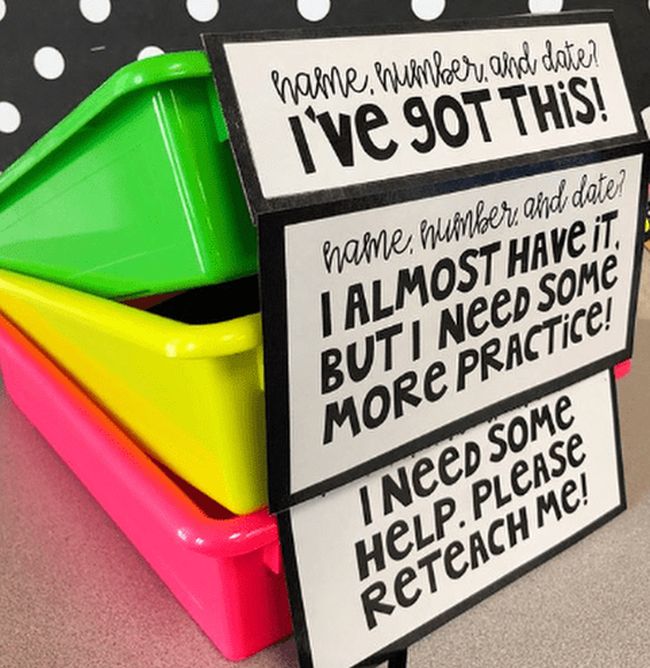
Crafting this project is a breeze with straightforward steps. Grab a presentation board folder, slice it in half, then join two halves to create openings on both sides. Personalize them with decorations or leave them as is—it’s all up to your creative flair!
11. Pom-poms to dry-erase markers
Want to jazz up your dry-erase markers? Adding pom-poms is the ultimate touch for a personalized classroom setup! Gather colorful pom-poms, dry-erase markers, and a trusty hot glue gun—it is a simple recipe for spicing up your markers in style!
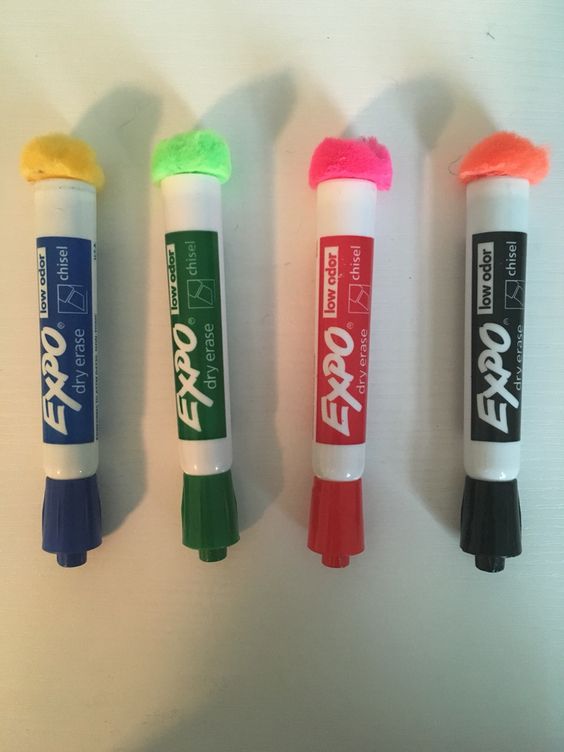
Gather your materials and ensure they’re clean and dry. Apply a small amount of hot glue to affix the pom-pom onto the dry-erase marker swiftly. Hold it firmly for a few minutes, and presto! Your customized marker is ready to rock the whiteboard!
12. Create marker sets
Kids tend to misplace markers, losing entire sets when caps go missing during class. Avoid this chaos by grabbing duct tape from the dollar store. Secure the markers together, ensuring your set stays complete, and prevents runaway markers from disrupting your class!
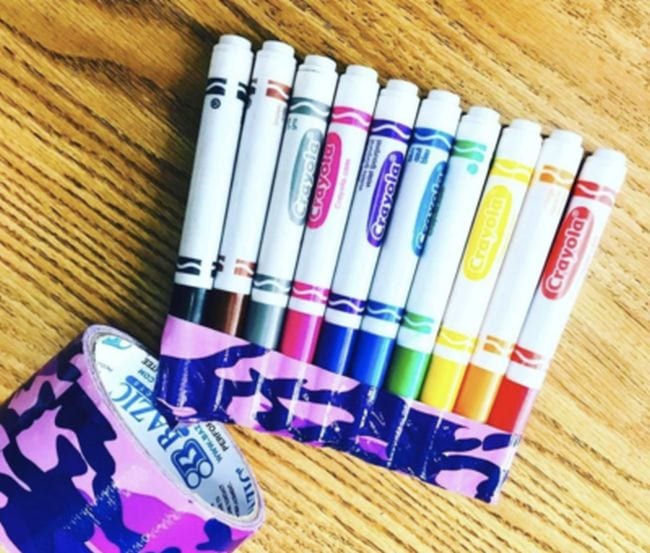
Arrange markers neatly in a stack and tape them together to maintain classroom tidiness and organization. Securing them prevents toppling, ensuring no markers go missing. Students can easily return them to the designated spot after use, keeping things orderly and hassle-free!
13. Store anchor charts on clip hangers
Utilize clip hangers for storing anchor charts—a brilliant method for organization and quick access! Before hanging, neatly roll or fold the charts according to their size and material. Ensure they’re in good condition to hang securely without any damage for easy retrieval when needed!

Place the clip hangers on the wall or in an area where you’d like to store your anchor charts. You can attach them to hooks, nails, or a hanging system suitable for the weight of the charts. Open the clips or clamps on the hangers and gently place the anchor charts within them.
14. Flip a crate for scissor storage
Flipping a crate for scissor storage is a clever and practical idea! Select a crate that’s large enough to accommodate your scissors. Wooden or sturdy plastic crates work well for this purpose. You can also paint or seal the crate if you’d like to personalize or protect it.
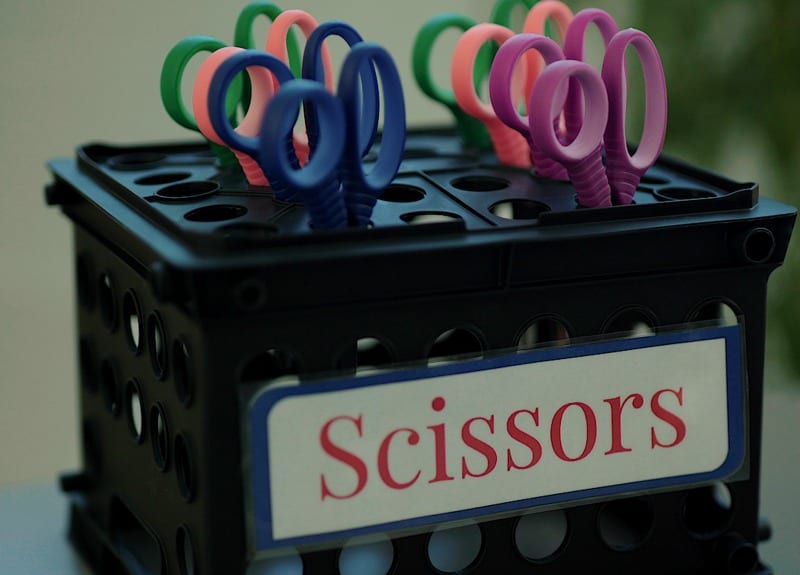
Turn the crate upside down so that the open side is facing downward. The base of the crate will now serve as the top for storing the scissors. Depending on the size and design of the crate, you can place the scissors with their blades facing upward into the sections of the crate.
15. Use these cup caddies in so many ways
Cup caddies are versatile and can serve various purposes beyond holding cups. Store pens, pencils, markers, scissors, and other small office supplies in each compartment of the caddy. It keeps your desk tidy and makes it easy to find what you need.

Use it to organize paint brushes, colored pencils, crayons, or other art supplies. The separate compartments can help sort different colors or sizes. Keep spatulas, whisks, wooden spoons, and other cooking utensils in the compartments. It’s convenient and can sit on your kitchen countertop or hang from a hook.
16. Turn a toothbrush case into a pencil holder
Making a pencil holder out of a toothbrush case is a clever and useful idea! Before using, make sure the toothbrush case has been properly cleaned and dried. Eliminate any debris or toothpaste residue. Put your markers, pens, and pencils inside the toothbrush case.

Use your imagination! Apply paint, washi tape, stickers, or other embellishments to give the toothbrush case a special appearance. To make it more visually appealing, you might add labels, graphics, or colors. You may need to reorganize the pieces to make them more comfortable, depending on how big the case is.
17. Supply them with erasers they aren’t likely to lose
Providing adorable or novelty erasers can make them more enticing to students and less likely to get misplaced. Choose erasers that come in various shapes, colors, and designs. Animal-shaped erasers, puzzle erasers, food-shaped erasers, or ones that resemble toys can capture the kids’ interest.

Consider erasers with keychain attachments or eraser toppers that can clip onto pencils. This way, they’re more likely to stay with the pencil and not get lost. Allow kids to personalize their erasers with stickers, markers, or small decorations. This gives them a sense of ownership.
18. Use book bins for student mailboxes
Choose magazine organizers or book bins that are sturdy, spacious enough to hold materials, and easy for students to access. Consider ones with a slot or open front for easy insertion and retrieval of items. Decide where in the classroom these mailboxes will be placed.

Assign each student a mailbox. Use labels or tags with their names written clearly for identification. For pre-readers or kindergarteners, include a picture or photo along with their names to help them recognize their mailbox. Add personal touches to the mailboxes for pre-readers. Alongside their names, include pictures, stickers, or symbols that represent each child.
19. Corral cables with binder clips
Using binder clips to corral and manage cables is a clever and affordable organization hack! Choose medium or large-sized binder clips, as these will have enough space to accommodate different cable sizes. Open the arms of the binder clips and attach them to the edge of the table or desk.

You can space them out evenly along the edge, depending on the number of cables you need to manage. Once the binder clips are secured to the table edge, thread the cables through the handles of the binder clips. The handles act as holders and prevent them from tangling or falling to the floor.
20. Set up turn-in-bins
Decide on the different levels of confidence for students to self-assess their understanding of the topic. This could range from high confidence to low confidence, or use descriptive labels that suit your classroom. Get separate bins or containers—one for each confidence level.

Label or designate each bin according to the confidence level it represents. Ensure they are easily accessible for students. Introduce the turn-in bins system to the students. Explain the different confidence levels and encourage them to self-assess their understanding before turning in their assignments.
21. Set out Tidy Tubs
Setting out Tidy Tubs in the form of labeled desktop bins can significantly help manage clutter and encourage cleanliness among students. Get small bins or containers that fit easily on students’ desks without taking up too much space. After that, get some papers or stickers and make labels.

Label each bin clearly as a “Tidy Tub” or “Mini Trash Can.” You can use colorful stickers to make them visually appealing and easily identifiable. Assign each student a Tidy Tub and place it on their desk. Ensure they understand its purpose: for disposing of small bits of trash or paper waste.
22. Remove permanent marker with dry-erase markers
Yes, using a dry-erase marker to remove permanent markers from a whiteboard can work effectively for your classroom. The alcohol content in the dry-erase marker ink can help dissolve the permanent marker ink, making it easier to erase both marks together.

Simply color over the permanent marker with the dry-erase marker, then wipe the board clean with a dry-erase eraser or cloth. Alcohol-based disinfecting wipes can also be used to remove permanent marker stains from a whiteboard. It should gradually lift the permanent marker off the whiteboard.
23. Hang plastic totes as cubbies
Hanging plastic totes as cubbies using sticky hooks is a smart way to create additional storage space, especially on brick walls. Choose plastic totes with handles that are sturdy and can accommodate the items you want to store. Ensure they have holes or handles that can hang securely from hooks.

Decide on the location and arrangement of the totes on the brick wall. Consider the size of the wall space and how many totes you want to hang. Use adhesive hooks specifically designed for brick walls. Clean the brick surface where you’ll place the hooks to ensure they adhere properly.
24. Attach letter trays underneath chairs
Attaching letter trays underneath chairs using zip ties is a fantastic idea to utilize space efficiently and provide additional storage for students. Turn the chair upside down or on its side to access the bottom area where you’ll attach the trays. Place the letter trays underneath the chair.

Use zip ties to attach the trays to the chair frame or legs securely. Thread the zip ties through the holes or handles of the trays and around the chair frame, then tighten them securely. Trim any excess length from the zip ties. Ensure the trays are securely attached and stable.
25. Store earbuds in a compartmented case
Earbuds can be stylishly kept untangled and conveniently accessible by storing them in a divided case or organizer. Choose an organizer or case with several parts or compartments. To prevent the earphones from getting tangled in the cables, the compartments should be the right size.

Before using, make sure the organizer is dry and clean. Dust or debris should be removed by cleaning the compartments if necessary. You can even store extra accessories—like various-sized ear tips or a charging cable—in different sections of the organizer if your earphones come with them.
26. Keep things organized at school and home
Set up bins, caddies, or shelves with essential supplies like pencils, erasers, rulers, paper, calculators, and other materials needed for homework. Provide reference books, dictionaries, or educational resources that students may need for their assignments. Ensure the seating is comfortable and conducive to studying.

Provide a desk or table along with a comfortable chair for the child to work on homework assignments. Allow the child to personalize their homework station with decorations, motivational posters, or their artwork to make it inviting and inspiring. Designate a specific area at home for homework—a quiet, well-lit space free from distractions.
27. Clean up glitter with play dough
Using play dough to clean up glitter is a creative and effective way to handle those sparkly spills without a vacuum. Take a small amount of play dough, preferably a fresh or unused portion. Knead it slightly to warm it up and make it more pliable. Gently press the play dough onto the glitter spill.

The sticky nature of the play dough will attract and lift the loose glitter particles. Continue pressing and lifting the play dough over the spill until most of the glitter is picked up. If necessary, use a new section of clean play dough to capture more glitter.
28. Use hand sanitizer bottles as hall passes
Hand sanitizer bottles in hall passes are a resourceful and practical idea, especially when hand sanitizer is readily available in classrooms. Choose small-sized hand sanitizer bottles that have a clip or holder, making them easy to carry and hang. You can attach these labels to the bottles.

Fill the bottles with hand sanitizer from larger bulk containers. Ensure they are securely closed to prevent leaks. Communicate to students that these hand sanitizer bottles will serve as hall passes. Establish clear guidelines on how they should be used and returned.
29. Stitch up some board eraser mitts
Lay out the large microfiber cloth on a flat surface. Estimate and mark the desired size for the eraser mitts. You can aim for smaller rectangles that can fit over a hand comfortably. Use scissors to cut along the marked lines, creating multiple smaller rectangles from the large microfiber cloth.

Stitch along the edges, leaving one side open to create a pocket-like mitt. Alternatively, if sewing by hand, use a simple running stitch along the edges. Slide your hand into the mitt and use it to erase the board. The microfiber material is effective at picking up dry-erase marker residue.
30. Use baby socks as dry-erase board erasers
If you see baby socks lying around and do not wish to toss it out just like that. You can just use it as an eraser for the board. Choose clean baby socks that are made of a material suitable for erasing dry-erase markers. Microfiber or soft cotton socks tend to work well.

Provide each student with a baby sock to use as their dry-erase board eraser. Instruct them to slip the sock over their hand and use it to wipe off the dry-erase marker from the board. Encourage students to shake or lightly pat the socks outside after each use to remove excess marker residue.
31. Clean desks with shaving cream
Students are going to fall in love with this dollar store hack. Squirt a moderate amount of shaving cream onto the desks, covering the areas with crayons, pencils, or glue marks. Encourage students to be creative and draw, write, or play with the shaving cream.

In a minute, you can see that the desks are clean. You can include this activity as one of your weekday activities, maybe a Thursday activity. The entire class can participate and you can also engage with the students. This way the team spirit skills can be enhanced.
32. Renew whiteboards with basic supplies
Its mild abrasiveness can help remove stubborn stains from a whiteboard. Apply a small amount on a cloth and gently rub the surface, then wipe clean with a damp cloth. A mixture of vinegar and water can act as a cleaning solution.

Use a fabric or spray bottle to apply the solution and wipe the whiteboard clean. Some suggest that the alcohol content in hairspray can help clean whiteboards. Spray a bit onto the board and wipe it off with a cloth. Apply a small amount on a cloth and rub it onto the surface.
33. Polish stainless steel with a dryer sheet
Using a dryer sheet to clean stainless steel is a common household hack. The anti-static properties of dryer sheets can help repel dust and reduce the visibility of fingerprints on stainless steel surfaces. Grab a regular dryer sheet, preferably unscented, as scented ones might leave residue or smell on the stainless steel.

Take the dryer sheet and rub it gently over the stainless steel surface in the direction of the grain. This helps remove fingerprints and adds a bit of shine. After using the dryer sheet, wipe the surface with a clean, dry cloth to ensure any residue from the dryer sheet is removed.
34. Try another way to clean your whiteboards
An amazing hack is to clean whiteboards with facial scrubbers! The slightly abrasive texture of facial scrubbers is usually useful in removing persistent markings and dried ink from whiteboard surfaces. Make sure the face scrubbers you buy from a store are new and clean.

Wet the face scrubber just a little bit with water. It should be just barely moist, not drenched. Utilizing the facial scrubber, gently clean the whiteboard surface. Apply circular motions or focus on stubbornly marked spots. After cleaning the surface, dry and clean the whiteboard with a fresh cloth.
35. Cut up paper plates to learn fractions
Paper plates are a great way to teach fractions, and it is a fantastic hands-on approach! Paper plates are convenient and easily accessible, making them great tools for visualizing and understanding fractions. Purchase packs of colored paper plates. Different colors can represent different fractions, aiding visual learning.

Using scissors, cut the paper plates into different fractional parts. For instance, cut one plate into halves, another into thirds, another into fourths, and so on. You can also cut them into more complex fractions like fifths, sixths, eighths, etc.
36. Roll and Write a story
Roll and Write activities are excellent for sparking creativity and imagination in young writers! Print out the Roll and Write story sheets in advance. These sheets typically have columns or sections for characters, settings, and plots. Introduce the activity to the students.

Have each student roll the dice three times, once for each category (character, setting, plot). For each roll, use the corresponding column on the sheet to note down what they rolled. Encourage students to use these elements as the basis for their story.
37. Play math facts War
Math Facts War is a fantastic game to reinforce arithmetic skills while making learning fun! Remove all face cards (kings, queens, jacks) from the deck, leaving only number cards (2-10). Rearrange the cards and deal them evenly between the players, face down. Each player keeps their cards in a stack without looking at them.

Simultaneously, both players flip over the top two cards from their stacks and place them face-up in front of them. Decide on the arithmetic operation to practice: addition, subtraction, or multiplication. The player with the highest total wins the round and collects all four cards (their two cards plus the opponent’s two cards).
38. Wear math facts name tags
Turning math facts into name tags not only makes learning fun but also reinforces those facts throughout the day. Prepare name tags for each student with a math fact problem written on it. Ensure the problems are suitable for the student’s grade level and skills.
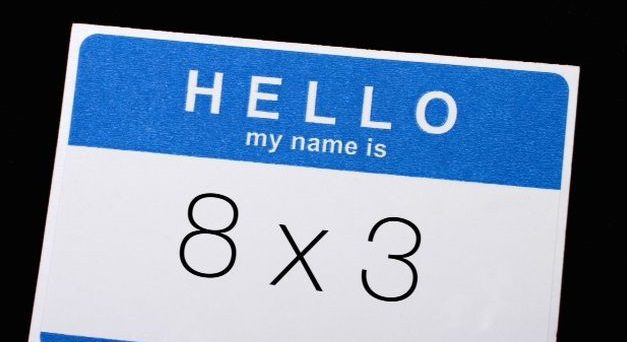
Distribute the name tags with math facts to each student at the beginning of the day. Make it a surprise or a fun activity to kick off the morning. Instruct the students that for the entire day, they are to refer to each other by the answer to the math fact.
39. Stack plastic cups
Stacking cups can indeed be surprisingly engaging for kids, and incorporating math into this activity adds an educational twist. Take a set of plastic cups and write different math facts on some cups. For example, write addition, subtraction, multiplication, or division problems on these cups.

You can adjust the complexity of the problems based on the student’s level. On the remaining cups, write the corresponding answers to the math problems you wrote on the other cups. Encourage the kids to stack the cups by matching the math fact cups with their correct answer cups.
40. Whack Ping-Pong balls to subtract
That sounds like an incredibly fun way to practice subtraction skills! Cut holes in the lid of the shoebox. These holes will serve as the “moles” that the Ping-Pong balls will pop through. Make sure the holes are large enough for the Ping-Pong balls to fit through easily.
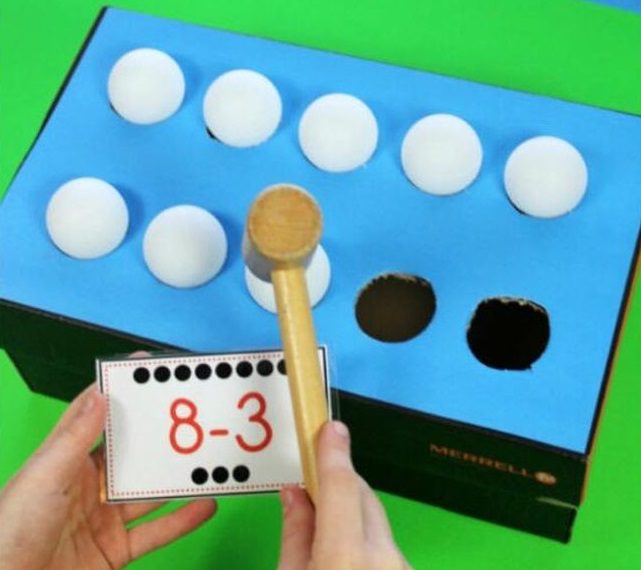
Label or number the holes with different subtraction problems. For example, you might write equations like “10 – 5” or “8 – 3” above each hole. Create corresponding “answers” on the Ping-Pong balls. Write the correct answers to the subtraction problems on the Ping-Pong balls using a marker.
41. Roll and Write a number sentences
Using dice for math games is a fantastic way to make learning more interactive! Have the students or players gather around a flat surface or table. Each participant takes turns rolling the two dice. After rolling the dice, the player creates a number sentence using the numbers rolled.

They can choose to form addition, subtraction, multiplication, or division equations using the two numbers. For instance, if a performer rolls a 3 and a 4, they might create different number sentences such as Addition: 3 + 4 = 7 or Subtraction: 4 – 3 = 1.
42. Build an engineering kit
A great approach to get youngsters involved in STEM (science, technology, engineering, and mathematics) activities is by making a DIY engineering kit. Add different kinds of building blocks, such as magnetic tiles, wooden blocks, or LEGO bricks. These foster ingenuity and technical proficiency.

Supplies such as straws, cardboard, tape, pipe cleaners, rubber bands, and popsicle sticks should be available. These materials can be used to build a variety of devices and structures. Add wheels, levers, pulleys, and gears to introduce the fundamental ideas of simple machines.
43. Pop bubbles to learn letters
Using bubble wrap to help pre-readers learn their letters is a fantastic idea! It’s a multisensory and tactile approach that makes learning fun. Lay out a piece of bubble wrap flat on a surface, ensuring the bubbles face upwards. Use a marker to write letters of the alphabet inside the bubbles.
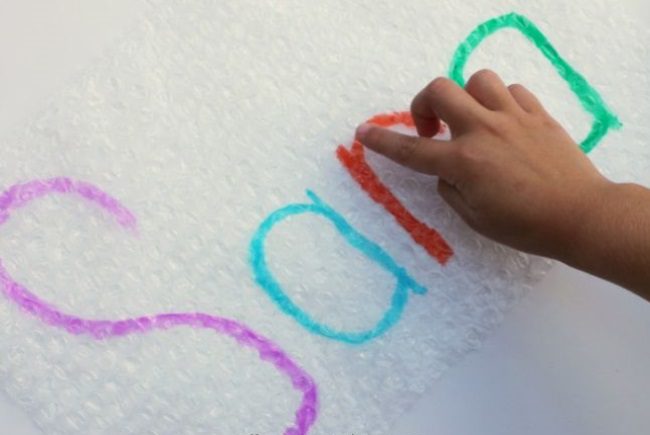
You can write uppercase, lowercase, or both, depending on the level of the pre-readers. Encourage the children to identify and say the letters aloud as they pop the bubbles. They can use their fingers or even objects like pens or styluses to pop the bubbles containing the letters.
44. Build brick letters
Building letters with building bricks is a fantastic way to combine learning and play! If using free printable cards with letter templates, print them out before starting the activity. These templates will serve as a visual guide for kids to build the letters.

Select a letter to focus on. You can start with the letters of the child’s name or begin with the alphabet in sequence. As they build each letter, they talk about the letter’s name, its sound, and words that start with that letter. Encourage them to recognize and name the letters they are building.
45. Put together craft stick name puzzles
Craft stick name puzzles are a fantastic hands-on activity to help kids learn names, sight words, and spelling in an interactive way. Lay the craft sticks flat next to each other to form a solid surface. Apply Mod Podge or glue across the sticks, covering the entire surface.
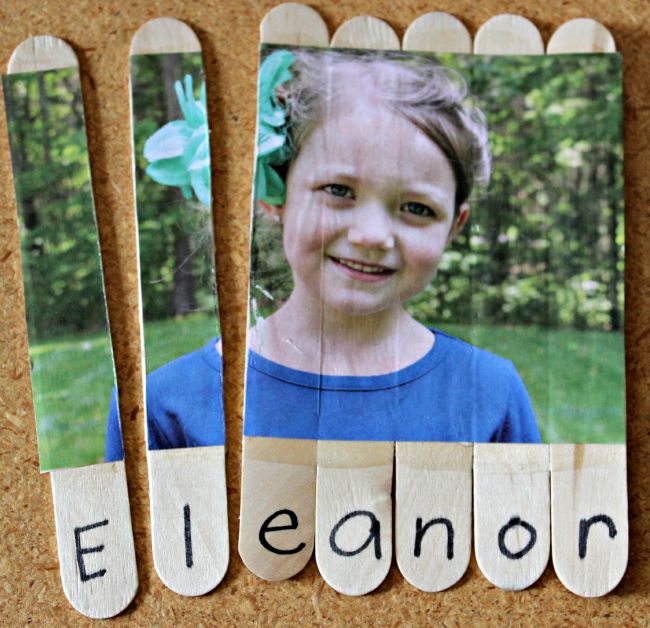
Place a photo or picture representing the name or sight word on the glued surface of the sticks. Ensure it covers the entire area of the sticks. Use a marker or pen to write one letter of the name or sight word on each stick. Write the letters in order to spell out the name.
